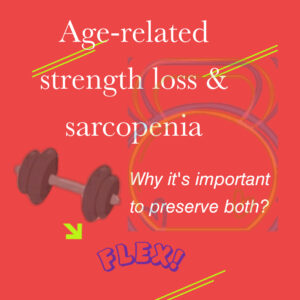
Age-related dynapenia (strength loss) and sarcopenia
Maintaining strength vs. muscle mass is equally essential to the aging population. The aim to preserve strength is equally important to the aging population as maintaining muscle mass. Muscle mass protects metabolic function, while strength protects neuromuscular function and prolongs physical independence in older adults.
Individuals aged 65 and older are the fastest-growing population globally, with profound implications for the global optimization of healthy aging. This group may be more susceptible to anabolic resistance due to advanced chronological age; however, this is not inevitable. Maintaining strength and muscle is critical. Evidence indicates lifestyle habits that facilitate exercise, body fat level, and protein/nutrient intake can mitigate age-related myofibrillar protein synthesis (MPS) impairment.
Maintaining muscle mass
Resistance training is more effective than endurance training at stimulating myofibrillar protein synthesis. Current evidence favors post-exercise as the time when rapid hyperaminoacidemia promotes a marked rise in the rate of MPS. While resistance training and hyperaminoacidemia both stimulate MPS, it is through the synergistic effects of these two stimuli that a net gain in muscle proteins occurs, and muscle fiber hypertrophy occurs. Dietary proteins that contain all the essential amino acids, high in leucine, and digest rapidly are more likely to be effective. Potentially beneficial supplements to stave off anabolic resistance include leucine, EAA, creatine, vitamin D, n-3PUFA, and HMB.
Protein requirements
Experts recommend a higher protein intake of .6 g/kg/day– 2.2g/kg/day for maximizing muscle anabolism in combination with structured exercise.
Per-meal protein intake is optimized at approximately 0.4 g/kg– 0.6 g/kg in older individuals, consumed at least 3–4 times through the day to reach this recommended daily total. Calory restriction also requires higher protein intake because it compromises lean mass preservation.
Potentially beneficial supplements to stave off anabolic resistance include leucine, EAA, creatine, vitamin D, n-3PUFA, and HMB.
A physically active lifestyle that regularly challenges the musculoskeletal system should focus on maintaining good muscle mass levels. Obesity can exacerbate anabolic resistance, so the effectiveness of nutrition and exercise for mitigating anabolic resistance is enhanced when keeping adiposity under control.
Read the complete paper – https://pubmed.ncbi.nlm.nih.gov/36018750/, and Scilit | Article – A Brief Review of Critical Processes in Exercise …. https://www.scilit.net/article/42ee2f45e1c1b1779c4bf0ed9258331c
Take Action Now
Explore Strength Training for Mid-life Women
Learn how strength training can boost your health and vitality. Click here for more information.
Join Our 12-week Program
Kickstart your fitness journey with our 12-week program. Get started Now.
Connect with Us on Facebook
Join the Meno Fit group on Facebook to share your story and connect with others. Join Here.

Comments are closed.